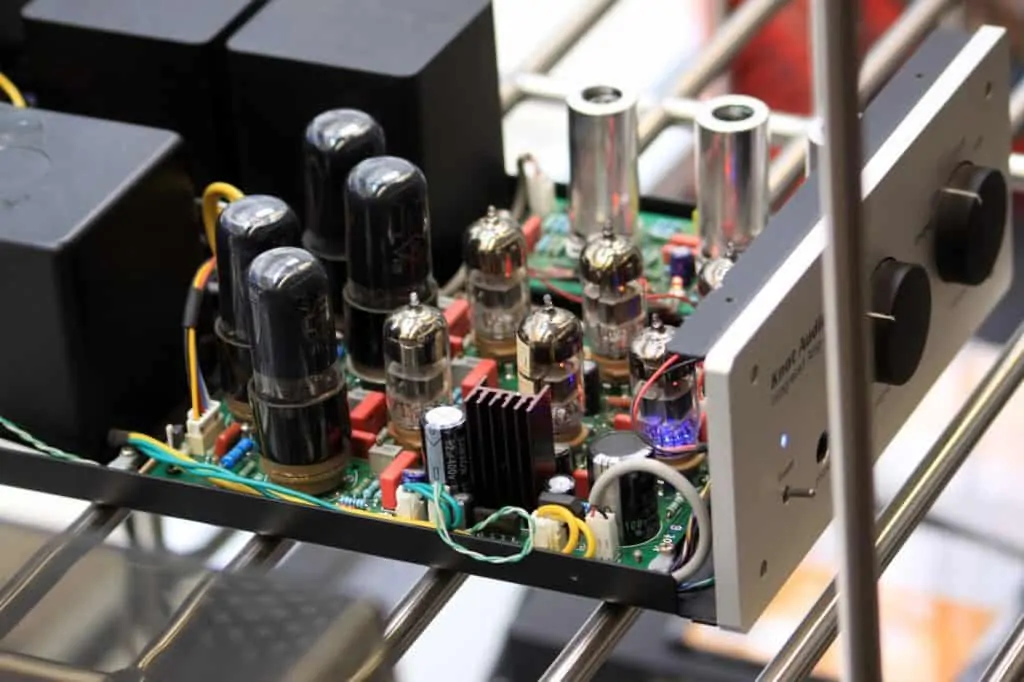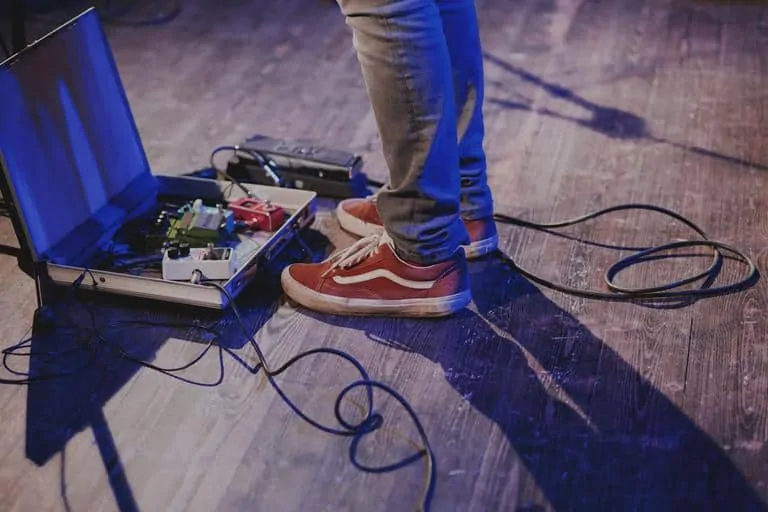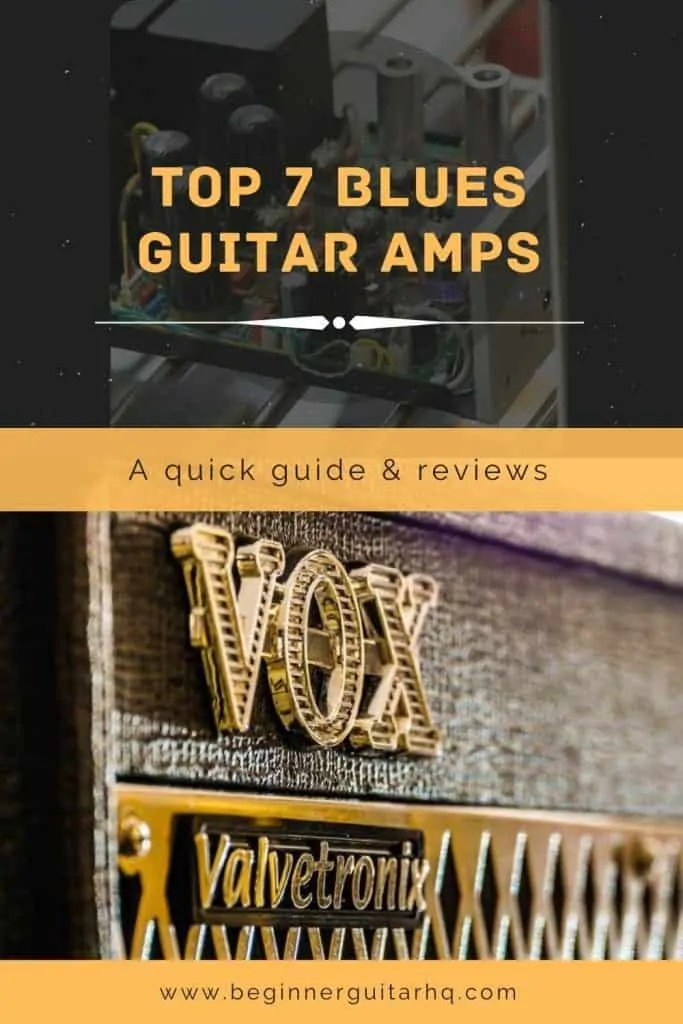Let’s start by saying “blues” is a near-extinct musical genre. At least regarding commercial success. Various decades have passed since blues musicians have topped the charts or hit the radio. Why would you need the best blues amp, then?
We know the answer. You’re looking for perfection, as you are a bluesman or a blueslady yourself. The genre might be long gone from mainstream spaces, but that doesn’t erase its legacy. Blues is the origin of most modern music styles. So, many professional musicians start the academy by studying both blues and jazz.
As a blues player, I understand if you’re looking for perfection. Or, at least, the best possible tone you can squeeze with your budget.
That’s why we’re here. We’re covering the best blues amps you can buy right now, and we’ll be traveling from entry-level options to premium alternatives. Naturally, that means we’re leaving behind iconic valve tube amplifiers you wouldn’t be able to find nowadays.
First off, though, we need to cover some basics. Blues is such a heavily complex genre, we’ll need to teach you how to find the best blues amp you can afford.
The best blues amps need to have certain characteristics. For example, they need to be dynamic and precise to catch the genre’s bends and slides.
Before you buy a blues amplifier or a blues guitar, I advise you to check a couple of guides on the matter. That’s if you’re a beginner, though.
Here’s some prior info that might help you:
Contents
How to find the best blues amps for electric guitar?
There’re endless guitar amps models in today’s market. They ship with different sizes, features, speakers, wirings, and designs.
I will be covering some points regarding guitar amps to streamline our selection. I’ll also link our other guides as we go along if you’re looking for something else instead.
Overall, here’s what I’m covering:
- Valve tube amps are the best option for general blues guitar
- Essential guitar amp features
- When to consider solid-state amplifiers
I intend to give you the information you need to make an informed decision.
“Meteoro Classic Cristalino tube guitar amp” by ligia diniz / CC BY 2.0 Many guitar brands are still producing tubular amplifiers. They follow traditional design choices to simulate or improve upon the vintage guitar sound.
Valve tube amps for blues guitars
Vintage amplifiers were hand-wired and hand-built. Instead of today’s solid-state models, amplifiers of old used vacuum tubes to create and modify the guitar’s sound.
And because blues and jazz were the first amplified musical genres, it’s safe to say that the sound of a tubular amp equals the sound of blues.
Beyond that, tubular amps have been part of the sound of nearly every rock & roll and blues guitar player since they entered the market in the ’40s decade.
That’s because of the essential feature of tubular amps. They have a lot of headroom and power. Moreover, you can burst into a natural overdrive and go back to subtle tones only by your strumming strength.
Then, when you crank the volume up, you get warm and organic sounds. That turns into beautiful overdrives with a high dynamic response, meaning there’s a lot of difference between your highs and your lows to play around.
So, overall, tube amplifiers respond to your playing and your volume controls. They also deliver rich dynamics, natural overdrives, and plenty of headroom for extra pedals.
Bear in mind that most tubular amplifiers are expensive. Also, tubular amps need regular maintenance and repairs.
With that said, some solid-state and modeling models are well worth a spot on our best blues amps list.
Here’re the differences between the two main guitar amp categories in detail.
<iframe width=”1044″ height=”587″ src=”https://www.youtube.com/embed/qRvRZNg8L0w” frameborder=”0″ allow=”accelerometer; autoplay; clipboard-write; encrypted-media; gyroscope; picture-in-picture” allowfullscreen></iframe>
Essential guitar amp features
If you decide on a tubular amplifier, the challenge becomes easier. Otherwise, we need to look for solid-state amplifiers that deliver similar performances.
Still, we need to understand a couple of things about tube amplifiers.
Most speakers try to amplify the signal with as little noise, distortion, and hum possible. Their role is to make the natural tone of your instrument or voice audible to a broader audience.
That was also the original idea of guitar amplifiers, but then guitar players began using them differently. For example, breaking the internal speakers of the amp to create a fuzz effect.
Moreover, early blues and rock & roll players began overloading the amplifier. When the volume is high enough, the guitar’s signal breaks into a light and medium clipping.
As it turns out, audiences loved that sound, and it endured in the modern rock era.
Essentially, the valve amplifier begins to overdrive when it can’t handle the signal’s strength anymore. That’s what drive pedals want to imitate.
Furthermore, tube amps go towards overdrive smoothly as you push your guitar and your amp harder. That means they won’t reproduce your sound naturally as they will instead as dirt and clipping effects. Yet, they keep harmony and clarity as they go up.
The overdrive level depends on the amplifier’s built quality and components. It also depends on the guitar, as well as your playing experience.
Having said that, we need to review the core features all guitar amplifiers share: preamp, power amp, channels, output, and speakers. Plus, we’re discussing valve tube qualities as well.
<iframe width=”1044″ height=”587″ src=”https://www.youtube.com/embed/QoGiW2h68k4″ frameborder=”0″ allow=”accelerometer; autoplay; clipboard-write; encrypted-media; gyroscope; picture-in-picture” allowfullscreen></iframe>
Preamp
The preamp takes your guitar’s signal, amplifies it, and sends it to the power amp.
As the first section of the enclosure, it can’t handle a lot of power. That’s why the preamp area commonly features non-intrusive controls like volume, gain, EQ, brightness switch, texture, and similar.
The preamp stage also takes care of shaping the tone of the guitar.
Some preamps can handle some extra power. They make it easier to reach overloaded tones at lower volumes. You would notice these options because they have an extra overdrive or distortion knob.
These options are great if you need to play at lower volumes. You would be able to reach the natural tubular distortion without raising the volume by much.
Effects
In between the power and the preamp comes the effects. There’re not many tube amps with built-in effects, though.
Commonly, you’d find options with reverb, chorus, flangers, vibrato, or some other forms of modulations. The quality of these effects varies, from practice solutions to full-blown stage-ready sounds. You may consider them depending on your current roster of guitar pedals.
You wouldn’t want an extra delay if you already got a delay pedal you want.
Power amp
Then comes the power amp, which is the section that generates the guitar’s power and the majority of the volume.
In other words, it takes the line-level signal of the preamp and increases the volume dramatically.
There’s no tonal shapíng in this section, though, only raw power. That said, the latter stage is more robust and thus can push the guitar to overdrive better.
That means you can play at higher volumes without bursting to overdrive. In other words, you may have to crank your guitar’s volume plus the amp’s volume knob to reach driven sounds.
Speaker
The speaker pushes the sound onward after the power amplifier. It’s the part that makes the signal audible. Naturally, the size, built materials, number of speakers, and brand affect the tone.
As a general rule of thumb, you’d want silver-cone or V-shaped speakers. Brands like Celestion, Eminence, and even Fender create the best alternatives.
VIntage speakers, for example, were ineffective; they couldn’t handle higher volumes, so they gave overdriven sounds. Speakers branded with the “vintage” word tend to imitate those results.
Modern speakers, though, will behave differently. They may change the guitar’s tone as they can remain focused and in control at higher headrooms.
The most common size of guitar amp speakers is 10” in diameter. Some amplifiers have one speaker, whereas others have two. Some rare models even have a power amp running the sound to each speaker.
Combos vs. stacks
In that same regard, you’ll need to choose between amplifier combos or amplifier stacks.
A combo brings the preamp stage knobs plus the cabinet on the same enclosure. A stack, though, is when you combine a head with a cabinet.
Amplifier heads tend to be top-tier devices. They deliver extra tonal shaping options. Furthermore, they can transform and improve the sound of your guitar.
Some amplifier heads can create the sound for room practice and home studios, while others don’t. More specifically, the head has the preamp and power amp, but the speakers come in the cabinet.
Then, there’s a bunch of cabinets you can buy to mix and match. That’s the thing: you can either go for a branded head & cabinet option or test for yourself. I wouldn’t recommend the latter for beginners or intermediate players, as we’re talking about a professional option instead.
I also want to add that there’s nothing wrong with a combo amplifier. They can have as much quality as a head & cabinet combo. However, they won’t present the same versatility as building a stack yourself by mixing, for example, a particular cabinet you like with the knobs of another guitar head amp.
You can use tube heads with solid-state speakers and vice-versa. You can also pair a single guitar amp head with two cabinets to create a stereo sound.
Power tubes
Solid-state amps use transistors on both the power amp and preamp stages. Tubular amps, though, use vacuum tubes.
The quality and type of tubes have an impact on your tone.
Here’re the most common tubes you may find when browsing through the best blues amps for guitar:
- 6L6: By far the most common category, and also one of the first. Fender introduced 6L6 tubes, so they created the “American” rock sound. These tubes work on clean amplifiers with plenty of headroom, which is why they are present on big guitar amplifiers.
- EL34: The EL34 tubes produce British sounds instead, and they are a common choice for manufacturers like Orange, Marshall, and Vox. EL34 pipes can burst into overdrive quickly, and so they work with both low-gain and high-gain amps.
- EL84: These have similar characteristics to the EL34. The difference is these are smaller items and break up faster. You may find these tubes on the famous Vox AC30 lineup. They are a big part of why Vox’s reputed amp series come out with defined high ends and bites.
- 6V6: The 6V6 are a smaller, cheaper version of the 6LS tubes. They represent glassy and clean American tones. Keep in mind that these don’t have as much headroom as the 6L6 alternatives, which is why they are common on smaller amps like the Fender Princeton or the Deluxe Reverb.
- 12AX7 / ECC83: The 12AX7 is a modern alternative suited for preamp stages. They produce medium gains and medium overdrives. Overall, these are balanced and safe options.
Some amplifiers have more than two power tubes on the preamp section, in which case they use a phase splitter valve. The phase splitter valve works between the preamp and the power amp and uniquely drives the signal.
We’re not getting extra technical here. What you need to know is that phase splitter valves are standard on British amps. They convert the original signal into two opposite signals for the power tubes. As a result, you get more harmonics and a richer, crunchier tone.
As you use the tubular amplifier, the tubes will start to wear down. That brings less volume and overall less consistent tone, which is why you need to replace the pipes twice every year, at least.
American vs. British tones
We have to make a simple distinction between American and British amps. To put it plainly, Fender created the American guitar amplifier sound. Blues/rock musicians like B.B King, Elvis Presley, and Stevie Ray Vaughan are examples.
American sound comes with gorgeous cleans and plenty of headroom. They don’t burst into overdrive quickly, and so the driven tones are more subtle.
British voices are dirtier and grittier. There’s fine dirt even on its clean tones.
Moreover, British amps go into overdrive quickly, and so they feature less headroom. At the same time, they feature extra mid-range.
Some examples include Jimmy Page, Gary Moore, Jimmy Hendrix, and Eric Clapton.
Amplifier tone
Finally, you have to consider the amplifier’s tone, which is a purely subjective matter.
Generally, combo amps are the best choice for most players. They are practical, easier to use, and feature in-built tonal shaping options.
The benefits of a stack won’t be relevant to non-professional guitar players. Instead, you’d need to focus on how the amplifier actually sounds and whether or not you’d like that on a blues guitar amp.
Vox is one of the top brands creating tubular guitar amplifiers. Their offerings are expensive, though.
When to consider solid-state amplifiers?
Sound purists, professional musicians, and enthusiasts alike can swear on the quality of tubular amps. Everything I said is true and indeed spectacular.
However, as technology advances, solid-state amps become better and better. Some can genuinely recreate the qualities, tones, and built-in effects of vintage enclosures; others can go beyond.
There’s also modeling technology, in which powerful AI and circuit boards deliver “amplifier voices” to create different sounds.
On top of that, advanced digital amplifiers carry impressive features like tons of built-in effects, stereo sound, PC software to create and save presets, direct USB recording, mobile apps, and more.
Moreover, solid-state amps remain more focused as you raise or lower the volume. They won’t burst into overdrive and, the better the amp is, they feature extra headroom for pedals. As you lower or raise the volume, the amp will only sound louder or softer, which is why there’re so many good solid-state metal amps.
Another thing to consider is cost. A professional, large solid-state amplifier sells for about the same as an “affordable” tube amplifier. And you won’t need to invest in regular maintenance or anything like that.
So, answering the question, here’s when to consider a solid-state model as the best blues amps:
- When you already have drive pedals you like.
- When you need the extra versatility for other genres as well.
- If you like the options of a modeling amplifier -voices, built-in effects,…
- If you’re looking to record your electric guitar at home via direct USB recording, without an extra interface.
- When your budget can’t allow a tubular amp.
- When you don’t even like vintage guitar sounds, and you prefer something new and exciting.
- If you’re looking for an amplifier that gives you more control over your tone. You can control going in and out distortion with your pedalboard, your DAW, or your VST.
However, bear in mind that the ability to go in and out distortion without thinking about pedals can allow you to solo and improvise better. That’s a core ability for blues playing, which is why I’m recommending tubular models instead.
Moreover, blues playing needs your full attention on the guitar and less attention to different effects and options. Tube amplifiers are commonly straightforward and easy to use. They don’t need extra attention from you: create the single tone you like with these amps, and play without moving the knobs anymore.
<iframe width=”948″ height=”533″ src=”https://www.youtube.com/embed/ZGNoXh7gL3U” frameborder=”0″ allow=”accelerometer; autoplay; clipboard-write; encrypted-media; gyroscope; picture-in-picture” allowfullscreen></iframe>
Best blues amps reviews
With all of this new information at hand, it’s time to review the best amps for blues.
Your choice must come down to preference, budget, and personal taste. Either way, these are the top seven amplifiers I recommend for playing blues.
Naturally, most choices are tubular amps, but there are some solid-state and modeling models as well.
We have different sizes, from players looking to practice at home to rehearsals, studio recording, and stages.
Above everything else, though, we’re looking for an amplifier that’s capable of creating a bluesy tone without needing any extra pedals.
If you need to use an overdrive pedal to create a bluesy tone on the amplifier, then it’s not a “blues” amp.
Best overall blues amp Fender Blues Deluxe Edition (reissue)
The 40-watts Fender Blues Deluxe Reissue is the best overall blues amp you can buy right now. We consider its price very fair for its size and features, although it goes beyond mid-tier budget levels.
The Fender Blues Deluxe is a favorite pick for rock and country musicians. It’s an American, vintage tubular amplifier with the classic features Fender brings.
For starters, the rich tone of its tubes is hard to pass. On top of that, we have a control panel full of features and a chrome finish for a luxurious style.
The amp comes with a 12″ Special Design Eminence speaker, two 6L6 power tubes, and three 12AX7 preamp tubes.
It includes two channels, one for cleans & brights, and the other for drive. With the included two-button footswitch, you can go from country to classic rock, blues, and beyond.
Moreover, the amplifier includes Fender’s reputed Spring Reverb effect. Similarly, it consists of a 3-band EQ on a fairly straightforward layout.
I should mention the reissue carries an improved circuitry over the original. That means it doesn’t bring any of the prior hums the old version has.
Overall, the Blues Deluxe is a vintage tube amp with a boutique tone and a luxurious look. Do you want to sound like a pro? This would be your choice.
<iframe width=”948″ height=”533″ src=”https://www.youtube.com/embed/oM9m8tIAiwI” frameborder=”0″ allow=”accelerometer; autoplay; clipboard-write; encrypted-media; gyroscope; picture-in-picture” allowfullscreen></iframe>
Best premium blues amp: Marshall Studio Vintage SV20C
Jim Marshall opened Marshall amps in 1960 with his son. It became a popular hit with various notorious British Musicians, like The Who’s Pete Townshend.
However, these musicians began to complain about the size of the amps by the time. As a response, Jim and Terry Marshall created the first 100-watts combo amplifier, the JMT 45 – it no longer exists.
A modern alternative is the Marshall Limited Studio Vintage. It follows the JMT’s tradition. It breaks into overdrive quickly and delivers aggressive, biting sounds.
It’s the reason why the original model became popular in blues and early rock musicians like Billy Gibbons, Duane Allman, Eric Clapton, Jimi Hendrix, and Jimmy Page.
It’s not a huge stack, though, and it’s also not a stage-ready amplifier. Instead, the Marshall Studio Vintage follows the iconic Super Lead 1959′ Lead 59′ Plexi. The original model was a hand-wired amplifier head led by Eric Clapton, Peter Townsend, and Jimmy Page.
It’s a 20-watts tube amplifier with a 10’’ Celestion V-type Speaker. Furthermore, it has a special preamp section with three power tubes (2 X 12AX7 plus 1 X 12AX7 phase splitter). It allows the amp to easily break into overdrive, with a rich mid-high presence and plenty of crunch.
The power section comes with 2 X EL34 vacuum tubes, enough to blow your home studio.
As for controls, the Vintage Studio combo amplifier presents plenty of options. The tone-shaping comes with a 3-band EQ (bass, middle, and treble), High Treble/Loudness I – High Treble/Loudness II, and Normal/Loudness II Controls. It also has a Presence knob, plus a Low/High Power selector switch.
These knobs allow you to go from dark to warm and bright. The sonic options are generous.
Everything works on four inputs (two highs and two lows). That keeps in tune with old school channel designs. You can tie the two channels together with the proper cable to blend both high and low voices.
The amp becomes complete with a rear FX loop and a power reduction feature that can lower the amp towards 5-watts. It also comes with plenty of options for speakers out to play live.
Check the tone below: it sounds like old-school leading British blues. It’s also a very loud amplifier, enough to work on small presentations and suitable to run on a PA system to great results.
<iframe width=”948″ height=”533″ src=”https://www.youtube.com/embed/2-kS4Kcaryw” frameborder=”0″ allow=”accelerometer; autoplay; clipboard-write; encrypted-media; gyroscope; picture-in-picture” allowfullscreen></iframe>
Best small blues amp: Blackstar Studio 10
The Blackstar Studio 10 EL34 is the kind of tube guitar amp you’d want to use through a PA system. It’s a small 10-watts model offering a boutique sound and selling for a significant price-tag.
Don’t get fooled by its small size. You can harness its home-jamming power at the studio or at the stage as well. It’s a tour-ready amplifier that’s light and easy to carry.
It brings a classic British tone from its EL34 power amp / 12AX7 preamp valve. Then, a vintage Celestion 12′ speaker pushes a creamy and sweet blues sound forward.
On top of that, the amp provides a professional studio-grade reverb to enhance your tonal presence.
All of this comes with a single input and a straightforward layout. It’s a plug & play amplifier that needs minimal effort to create excellent results.
<iframe width=”948″ height=”533″ src=”https://www.youtube.com/embed/9RjpltHpxR8″ frameborder=”0″ allow=”accelerometer; autoplay; clipboard-write; encrypted-media; gyroscope; picture-in-picture” allowfullscreen></iframe>
Best value blues amp: Marshall Combo Guitar Amplifier M-DSL40CR-U
The Marshal DSL20C offers enough versatility to go from blues to heavy metal. That said, it’s the best equipment for guitar players who want to invest in something that grows with their skills and preferences.
It has an all-tube circuit that creates Marshall’s rich amplifier tones. Then, the sound comes from a V-shaped Celestion 12” speaker. Plus, the amp’s semi-open back improves the signal’s focus and the clarity of low-end notes.
The power comes from four 12AX7 preamp tubes plus two EL34 power valves. The resulting power is 40-watts.
It has two channels (Clean and Ultra). These channels share the EQ section, so you can adjust the lows, mids, highs, resonance, and presence of both with the same knobs.
Then, each channel features its gain and volume controls. There’s also Reverb and Tone Shift knobs to craft your sound with precision, giving you vast amounts of control over your musical genres.
Another feature I want to mention is the ability to lower the wattage to 10 or 20-watts. It allows you to play at different locations without losing the natural overdriven qualities of the amplifier.
At the rear, you have outputs for a footswitch and FX loop.
Lastly, the design of the Marshall amp is durable and quite ready for the road.
I’d say this model delivers the definitive Marshall tubular experience without the hefty price tags.
<iframe width=”948″ height=”533″ src=”https://www.youtube.com/embed/PQvenmd-faA” frameborder=”0″ allow=”accelerometer; autoplay; clipboard-write; encrypted-media; gyroscope; picture-in-picture” allowfullscreen></iframe>
Best mini blues amp: Vox AC4C1-12
Vox is the most reputed British guitar amp company. They rose to fame with the original AC15 tubular amp. It’s the AC series’s first entry, which keeps delivering both modern and vintage top-tier models.
The AC15 was part of mythical bands like The Beatles, The Yardbirds, and The Rolling Stones. Eventually, the AC15 gave way to its bigger brother, the AC30. The newer model crafted rock sounds for bands like Oasis, The Foo Fighters, Red Hot CHilli Peppers, Nirvana, or The Arctic Monkeys.
Musical gear site Equipboard regards the item as one of the “Legendary Guitar Amplifiers to Rock your World.” Sadly, it’s widely expensive (more on that later).
We have a solution, though. The Vox AC4C1-12 brings forward the same qualities as the brand’s maximum example on a smaller enclosure. It’s not incredibly cheap, but if you’re looking for the best practice and home studio amp, the Vox AC4 is the best out there.
It’s a modern 4-watts version with upgraded circuits and a brand new 12” custom Celestion speaker. Furthermore, it has two 12AX7 preamp tubes plus one EL84 power tube. As a result of its configuration, the AC4 delivers clean sounds at lower gains and mild overdrives at about half the volume.
Its control cluster relies on gain, bass, volume, and treble knobs. They sit on top of the vinyl grille and vintage enclosure of the amp.
Overall, the AC4 is a Class A tubular amplifier that brings the best Vox offers on the smallest presentation they can muster.
Lastly, the AC4 is particularly friendly to extra guitar pedals and PA systems. That also makes it an excellent choice for recording with the right studio microphones.
<iframe width=”1044″ height=”587″ src=”https://www.youtube.com/embed/cICAOcR4Ktg” frameborder=”0″ allow=”accelerometer; autoplay; clipboard-write; encrypted-media; gyroscope; picture-in-picture” allowfullscreen></iframe>
Best solid-state blues amp: Boss Katana 100 MKII
Why scrapping savings to go for a mini tube amp when you can invest a bit more on a 100-watts solid-state behemoth?
The Boss Katana is a constant member on all of our amp reviews and recommendations. Simply put, it’s the modern digital amp available in the market.
We’re talking about the Boss KTN 100 Mark II, which doesn’t represent a tonal change against the original. What it brings are further options to craft your sound.
The amplifier brings 10 amp voices to choose from (compared to five) plus a broad effects section. It allows you to use 5 effects at the same time.
The MKII model is loud enough for most stages and brings the versatility you’d need as a modern, all-hands guitar player. If you learned guitar by playing blues and classic rock first, then the Katana will prove itself worthy with its many voices.
These preset sounds are Clean, Crunch, Lead, Brown, and Acoustic. In particular, the Brown voice comes from Eddie Van Halen’s Boss Waza amplifier. Then, the acoustic voice is crafted for acoustic-electric guitars.
You can simply select these voices with a rotary switch. If you want to play blues, then you should pick the Lead preset for a fiery playing.
Moreover, Boss approaches these voices with an AI they call “Tube Logic.” That means the amp can create tubular sounds consistently and effectively without needing the extra repairs. As a result, you have top-tier power, cutting presence, and leading punch.
On top of the sound presets, there are five effect sections. These include Delay, Reverb, Booster, Modulation, and various effects. There are three knobs on the effects section, and two of them have concentric mini-knobs for extra controls (like a Boss pedal). That allows you to tweak parameters, select different effect types, and set tap delay tempos.
You can access a deeper layer of FX controls through the included software, Boss Tone Studio. It allows you to customize and save presets using the amp’s 60 different effects, EQs, channel, flexible routing, and more. There are eight “Tone Settings” where you can store your presets and recall them as you play.
The rest of the controls include Gain, Volume, Presence, 3-band EQ, and Master volume. There’s also a wattage modulator to lower the output to 50-watts or 0.5-watts.
Hands down, it’s the most complete guitar amplifier there is. And it can sound just as good as a tubular model costing three times its price.
<iframe width=”1044″ height=”587″ src=”https://www.youtube.com/embed/QGbOvDYI41g” frameborder=”0″ allow=”accelerometer; autoplay; clipboard-write; encrypted-media; gyroscope; picture-in-picture” allowfullscreen></iframe>
If you need a smaller option by any chance, there’s also a Boss Katana 50 and a simplified Boss Katana 30 wireless amp.
Lastly, there’s a Boss Katana Head you can pair with an extra cabinet and get the same options like the combo version -on another speaker.
As you’re looking to play blues, here’s the best cabinet I can recommend for the genre:
There’s a Katana cabinet amplifier, in case you’re wondering. The option exists because it’s bigger than the combo version, and you could actually pair two of these if you’d like to create a stereo sound.
Best budget blues amp: Marshall CODE
Because we mentioned Marshall twice, I’m inclined to add a budget option for you.
You could go for the Marshall CODE modeling solid-state combo amp. It’s a fan favorite due to its wide range of tones and voices.
The whole deal of the CODE series is imitating vintage Marshall tubular amplifiers. It goes from perfect cleans to crunches without too much trouble.
That said, its top-notch ability to dial a multitude of tones on the fly makes it one of the best blues amps you can buy right now.
It works by modeling 14 Marshall preamps, 4 power amps, and 8 speakers.
All of its tones are consistent and authentic-sounding. And although it can’t deliver natural overdriven sounds, it works very well and is focused.
On top of that, you can connect the amp via BlueTooth to your mobile device o for some playback. That allows you to control the amp and its settings remotely. There’s also a direct USB connection to use with a DAW interface and record/stream audio from your computer.
<iframe width=”948″ height=”533″ src=”https://www.youtube.com/embed/8-DUNsPANA8″ frameborder=”0″ allow=”accelerometer; autoplay; clipboard-write; encrypted-media; gyroscope; picture-in-picture” allowfullscreen></iframe>
In Summary
As always, your choice ultimately comes down to preferences, budget, and tastes.
The most important part of the process is checking the demos or trying the amplifier yourself.
If you have any questions or suggestions, leave them in the comments below! Also, be sure to share the article with your musician friends.
As a final recommendation, I can guide you towards a resonator guitar if you’re just looking to play at home for fun (or similar).








